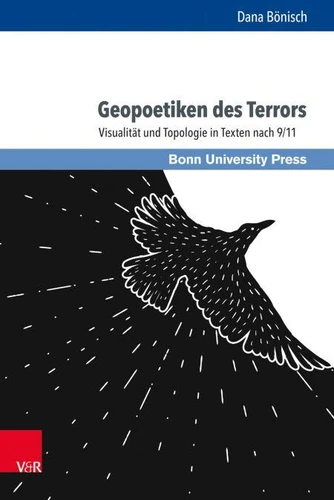Geopoetiken des Terrors. Visualität und Topologie in Texten nach 9/11
Par : ,Formats :
Disponible dans votre compte client Decitre ou Furet du Nord dès validation de votre commande. Le format PDF est :
- Compatible avec une lecture sur My Vivlio (smartphone, tablette, ordinateur)
- Compatible avec une lecture sur liseuses Vivlio
- Pour les liseuses autres que Vivlio, vous devez utiliser le logiciel Adobe Digital Edition. Non compatible avec la lecture sur les liseuses Kindle, Remarkable et Sony
 , qui est-ce ?
, qui est-ce ?Notre partenaire de plateforme de lecture numérique où vous retrouverez l'ensemble de vos ebooks gratuitement
Pour en savoir plus sur nos ebooks, consultez notre aide en ligne ici
- Nombre de pages235
- FormatPDF
- ISBN978-3-8470-0790-6
- EAN9783847007906
- Date de parution16/04/2018
- Protection num.pas de protection
- Taille3 Mo
- Infos supplémentairespdf
- ÉditeurV&R Unipress
Résumé
Der vorliegende Band nimmt eine Kopplung von Bild- und Raumtheorie vor, die den missing links zwischen beiden Bereichen nachspürt und sie gleichzeitig in Beziehung zu Erzählungen setzt. Aus dieser Verquickung wird erstmals eine Poetik asymmetrischer Kriegsführung im Zeitalter der Drohne entwickelt, die gemeinsame motivische Knotenpunkte in Fiktion, Theorie und medialem Diskurs in den Blick nimmt. Ausgangsmaterial ist eine zweite, bislang nahezu unbeachtet gebliebene Generation von Post-9/11-Romanen, die sich den globalen Kriegen der letzten Jahrzehnte zuwendet.
Dabei werden verschiedene Wissens-, Raum- und Blickordnungen verhandelt: von den stabilen Distanzen des euklidischen Raums zu den fluiden Koordinatennetzen der Topologie; von der Fernsicht des elektronischen Live-Feeds der Drohne zu Deleuzes vision rapprochée; und von den ikonischen Bildformeln des jungen Jahrtausends zu ihren Gegenentwürfen in der Literatur. Both a re-thinking of visual and spatial theory within the context of comparative literature and a poetics of global warfare, this book examines a new generation of Post-9/11 novels with regard to their production of different modes of vision and other forms of globality.
The analysis is framed by a new conception of geopoetics: Drawing on the works of Michel Serres and his philosophy of relationality, it argues that fiction's response to simplifying political narratives and visual regimes is informed by a topological concept of space that collapses metrical distance.
Dabei werden verschiedene Wissens-, Raum- und Blickordnungen verhandelt: von den stabilen Distanzen des euklidischen Raums zu den fluiden Koordinatennetzen der Topologie; von der Fernsicht des elektronischen Live-Feeds der Drohne zu Deleuzes vision rapprochée; und von den ikonischen Bildformeln des jungen Jahrtausends zu ihren Gegenentwürfen in der Literatur. Both a re-thinking of visual and spatial theory within the context of comparative literature and a poetics of global warfare, this book examines a new generation of Post-9/11 novels with regard to their production of different modes of vision and other forms of globality.
The analysis is framed by a new conception of geopoetics: Drawing on the works of Michel Serres and his philosophy of relationality, it argues that fiction's response to simplifying political narratives and visual regimes is informed by a topological concept of space that collapses metrical distance.
Der vorliegende Band nimmt eine Kopplung von Bild- und Raumtheorie vor, die den missing links zwischen beiden Bereichen nachspürt und sie gleichzeitig in Beziehung zu Erzählungen setzt. Aus dieser Verquickung wird erstmals eine Poetik asymmetrischer Kriegsführung im Zeitalter der Drohne entwickelt, die gemeinsame motivische Knotenpunkte in Fiktion, Theorie und medialem Diskurs in den Blick nimmt. Ausgangsmaterial ist eine zweite, bislang nahezu unbeachtet gebliebene Generation von Post-9/11-Romanen, die sich den globalen Kriegen der letzten Jahrzehnte zuwendet.
Dabei werden verschiedene Wissens-, Raum- und Blickordnungen verhandelt: von den stabilen Distanzen des euklidischen Raums zu den fluiden Koordinatennetzen der Topologie; von der Fernsicht des elektronischen Live-Feeds der Drohne zu Deleuzes vision rapprochée; und von den ikonischen Bildformeln des jungen Jahrtausends zu ihren Gegenentwürfen in der Literatur. Both a re-thinking of visual and spatial theory within the context of comparative literature and a poetics of global warfare, this book examines a new generation of Post-9/11 novels with regard to their production of different modes of vision and other forms of globality.
The analysis is framed by a new conception of geopoetics: Drawing on the works of Michel Serres and his philosophy of relationality, it argues that fiction's response to simplifying political narratives and visual regimes is informed by a topological concept of space that collapses metrical distance.
Dabei werden verschiedene Wissens-, Raum- und Blickordnungen verhandelt: von den stabilen Distanzen des euklidischen Raums zu den fluiden Koordinatennetzen der Topologie; von der Fernsicht des elektronischen Live-Feeds der Drohne zu Deleuzes vision rapprochée; und von den ikonischen Bildformeln des jungen Jahrtausends zu ihren Gegenentwürfen in der Literatur. Both a re-thinking of visual and spatial theory within the context of comparative literature and a poetics of global warfare, this book examines a new generation of Post-9/11 novels with regard to their production of different modes of vision and other forms of globality.
The analysis is framed by a new conception of geopoetics: Drawing on the works of Michel Serres and his philosophy of relationality, it argues that fiction's response to simplifying political narratives and visual regimes is informed by a topological concept of space that collapses metrical distance.



